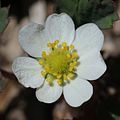| Fragaria iinumae | |
|---|---|
 | |
| Scientific classification | |
| Kingdom: | Plantae |
| Clade: | Tracheophytes |
| Clade: | Angiosperms |
| Clade: | Eudicots |
| Clade: | Rosids |
| Order: | Rosales |
| Family: | Rosaceae |
| Genus: | Fragaria |
| Species: | F. iinumae |
| Binomial name | |
| Fragaria iinumae | |
| Synonyms [1] | |
| |
Fragaria iinumae is a species of strawberry in the family Rosaceae . [1] [2] It is native to Japan and eastern Russia. [3] [4] [5]
Contents
In Japan it was first discovered on Mount Nōgōhaku (能郷白山, Nōgōhaku-san) and the name Nōgō Fragaria (ノウゴウイチゴ・能郷苺, Nōgō Ichigo) was given. [6] [7]
All strawberries have a base haploid count of 7 chromosomes. Fragaria iinumae is diploid, having 2 pairs of these chromosomes for a total of 14 chromosomes. [3] [4] [5] Fragaria iinumae is one of the diploid progenitors of the octoploid strawberry. [8]
- Flower
- Fruits
- Montage
| NCBI ID | 64939 |
|---|---|
| Ploidy | diploid |
| Number of chromosomes | 14 |
| Year of completion | 2014 |



